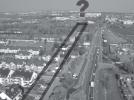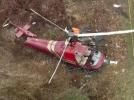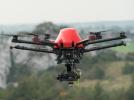Kenn Borek DHC6 at Antarctica on Jan 23rd 2013, impacted steep slope
Canada's TSB have released their final report concluding the probable causes of the crash were:
Findings as to causes and contributing factors
- The crew of C-GKBC made a turn prior to reaching the open region of the Ross Shelf. The aircraft might have entered an area covered by cloud that ultimately led to the aircraft contacting the rising terrain of Mount Elizabeth.
Other findings
- The cockpit voice recorder (CVR) was not serviceable at the time of the occurrence.
- The company did not have a practice in place to verify the functionality of the CVR prior to flight.
- The rate of climb recorded in the SkyTrac ISAT-100 tracking equipment prior to contacting terrain was consistent with the performance figures in the DHC-6 Twin Otter Series 300 Operating Data Manual 1-63-1, Revision 7.
The TSB reported that the captain of the flight (ATPL, 22,300 hours total, 7770 hours on type) had his 8th season in the Antarctic, while the first officer (CPL, 790 hours total, 450 hours on type) was in the Antarctic for the first time. Both had received training on high altitude flight operations, controlled flight into terrain and ground proximity warning systems. The captain had flown the route, leading to the crash, 16 times already.
The aircraft departed with 634 gallons of fuel. The aircraft climbed to 11,000 feet and called South Pole Station reporting all operations were normal. According to the GPS the aircraft proceeded along a track of 358 degrees true until about S87.3842 E164.8477 then descended to 10,000 feet. About an hour later the aircraft turned right to 032 degrees true, 2 minutes later descended to 9,100 feet, the crew radioed South Pole Station again reporting operations were normal at 07:27Z.
At 07:45Z the GPS shows a climb to 12,500 feet and a heading change to 350 degrees true. 12 minutes later the Skytrax system reported the last position of the aircraft at S83.8917 E168.5625, the next position reported expected at 08:27Z did not arrive prompting the activation of the emergency operations center, a search was initiated.
The ELT was first picked up at 08:57Z, the position of the aircraft was tracked down by 10:00Z. A search aircraft overflew the location at 12:05Z but was unable to establish radio contact and could not see down to the ground due to a low level cloud layer.
A Kenn Borek DC3T overflew the crash site at 22:00Z and circled the area for about 5 hours but was unable to establish radio contact and was unable to locate the crash site again due to cloud.
On Jan 26th 2013 at 03:25Z the crew of a LC-130 spotted the crash site followed by another Kenn Borek DHC6, but crews observed no activity.
On Jan 27th 2013 rescue workers were put down onto the ground by a helicopter and managed to get to the wreckage finding the roof of the aircraft had collapsed, the interior of the aircraft was filled with packed snow, there was avalanche activity around the aircraft. The cockpit voice recorder and the GPS aircraft tracking system were recovered from the tail of the aircraft, the recovery of the crew was not attempted due to blocked access to the cockpit area and obvious dangers to the rescue personnel.
The TSB reported the weather conditions at the time of the crash: "The atmospheric model indicated that, in the vicinity of Mount Elizabeth, the winds were generally from the east and not stronger than 35 knots at the time of the occurrence. Using the AMPS to forecast the cloud level in the area was also challenging. A measure of the total condensate in the atmosphere was analyzed, and indicated a relatively constant amount. As such, it would probably represent conditions at the time of the occurrence. The model indicated that it was likely that there was a widespread cloud layer over the Beardmore Glacier from 13 100 feet asl to 14 700 feet asl. A cloud layer over the Ross Shelf at the base of the Beardmore Glacier may have been at approximately 9800 feet asl. Weather conditions observed by SAR aircraft 4 ½ hours after the accident in the vicinity of Mount Elizabeth was a solid cloud deck, topping at approximately 16 000 feet asl, with a break in the clouds in the east grid. Mountain wave conditions with high winds and associated turbulence existed."
The TSB reported that the aircraft was not fitted, nor was it required to, with a working Terrain Awareness and Warning System (TAWS). Even though a TAWS was installed on the aircraft, it did not provide a database for further south than 70 degrees S and thus did not work in Antarctica.
The TSB analysed: "The circumstances surrounding the accident were difficult to determine given the limited access to the accident site and lack of data, which could have revealed details of the last moments of the flight. Data from the cockpit voice recorder would have been particularly useful. The unit was not functional on the occurrence flight; consequently, details of the flight crew’s interaction and decision making were not available to the investigation.
Information recovered from the SkyTrac ISAT-100 tracking unit enabled the investigation to reconstruct C-GKBC’s route. The reconstruction did not indicate any aircraft performance anomalies. Flight track, altitude, and ground speed remained relatively constant throughout the flight. At 0749, C-GKBC initiated a turn to the left that would have led directly to Terra Nova, but the aircraft’s altitude was insufficient to clear Mount Elizabeth.
Weather model analysis suggests that after the turn into the Beardmore Glacier, C-GKBC may have entered an area covered by cloud, and the crew’s view of Mount Elizabeth was likely to have been obscured. The occurrence aircraft was equipped with an FLTA system, and the initiation of a climb approximately 45 seconds prior to impact suggests that the crew might have responded to a terrain warning, but aircraft climb performance was not sufficient to avoid the terrain."
The wreckage (Photo: TSB/Alasdair Turner Photography):
Crash site overview (Photo: TSB/Alasdair Turner Photography):
Map with GPS Position Reports (Graphics: TSB/Google Earth):
http://avherald.com/h?article=45cad699/0000














Komentarze